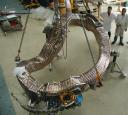Mar
18
What is a Stellarator?
March 18, 2008 | 8 Comments
The marvels of human imagination are astonishing. Way back in 1951 Lyman Spitzer at Princeton University proposed a design for plasma containment now called a stellarator. Stellarator is a word supposed to suggest a connection to a “star machine” and is being built by the Max Planck Institute as a way to contain plasma for fusion power generation. Like the tokamak, the stellarator is used to contain plasma so that the heat can be applied to a fuel and trigger fusion.
The difference from a tokamak is that the plasma isn’t carrying current. So the design isn’t a “donut” shape, rather it is a complex twisting path surrounded with high powered magnets that do the containment. The theory is that the carefully crafted and specialized path with high-powered magnetic containments will solve the issues that plague the tokamak. The models and study to date suggest that the simulations of the plasma behavior will not have or will have greatly reduced disruptions and instabilities that torment the tokamak researchers.
Only recently has the theoretical understanding, computing power and fabrication techniques developed to the level where construction can happen at sizes and power that will permit testing. The basis for the effort is the immense electrical demand to power a plasma charge in a tokamak that may be the issue that can never be solved in tokamak designs, which the stellarator isn’t required to use. This property of the theory offers a huge advantage to the economics of the large and very high temperature fusion efforts particularly as a fusion plant would need to run continuously. The lack of current would simplify the requirements for stability of the plasma and the control mechanisms and monitoring equipment should be much more simplified and less costly to develop.
There is one actually running. Called the TJII, this small unit has been used by CIEMAT, a Spanish research group, the U.S. Oakridge National Laboratory and Germany’s IPP Garching. The objective is to investigate the physics of a device with a helical magnetic axis and with flexibility in the magnetic configurations. It is triggered for half-second runs every five minutes.
Now the Greifswald branch of the Max Planck Institute of Plasma Physics has announced that they completed the first two half modules to their much larger stellarator. Called the Wendelstein 7-X this unit is planned to run up to 30 minutes, thus proving that the 57-year-old idea has legs with modern computing power and fabrication techniques. However, the purpose of the Wendelstein 7-X is evaluation of the main components that may be used in a future fusion reactor design using the stellarator concept.
It’s thought that if you can get the plasma to 100 million degrees Kelvin the introduction of a fuel will result in fusion with energy products to recover that may produce more power out than going in to run the unit. The Max Planck Institute isn’t offering that the Wendelstein 7-X project will generate power.
The drive behind the press release is that the Wendelstein 7-X unit construction has mated two of those massive and very complex parts together successfully. The release goes on to describe the steps that over six years will see the device become operational.
Most readers have enough know how to realize that these efforts can bring fruit in plasma physics and offer a great research tool to explore large plasma in a steady state with no interference from highly electrically charged plasma. Plasma is and will likely be much more useful as it becomes well understood and there are better means to control and exploit its properties.
But will it be a route to fusion? That question challenges, as the idea that such a temperature alone will simply kick off fusion isn’t conclusive. It isn’t known for certain that temperature alone will suffice. Temperature and pressure will certainly work, with evidence overhead. Speed alone will work, as Bussard has shown. Plasma alone might in fact work. Today Eric Lerner’s Focus Fusion using plasma may well be ahead of the stellarator though, at a much lower cost and perhaps more likely results in usable power out and much sooner too should arrangements be forthcoming to accelerate his work.
Comments
8 Comments so far





This web site is really a walk-through for all of the info you wanted about this and didn’t know who to ask. Glimpse here, and you’ll definitely discover it.
Hiya! I merely would like to give an enormous thumbs up for that good data you have got here for this post. We are coming again for your blog for additional soon.
Intriguing post. I have been searching for some good resources for solar panels and discovered your blog. Planning to bookmark this one!
Interesting read, perhaps the best article iv’e browse today. We learn everyday cheers to you!
Good! Thank you! I always wanted to write in my site something like that. Can I take part of your post to my blog?
I’ve just started off a blog, the knowledge you give on this site has aided me extremely. Thank you for all your time & work.
Lerner’s Focus Fusion is a delusional fantasy – http://mikebhopkins.wordpress.com/2012/06/20/why-lawrenceville-plasma-physics-results-are-not-even-wrong-a-detailed-analysis/
Great insights on stellarator technology and the Wendelstein 7-X! For those interested in sustainable energy, check out Energuys for innovative solar solutions in Germany: Energuys.